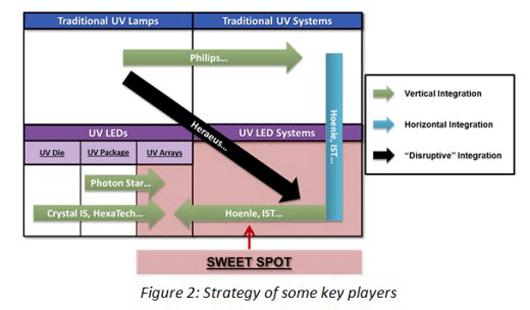- News
29 March 2012
UV LED market to grow five-fold to $150m by 2016
Due to their compactness, lower cost of ownership and environmental friendly composition, UV LEDs are continuing to replace traditional UV lamps in incumbent applications, but will also create new applications (especially portable ones) according to the report ‘UV LED Market’ from market analyst firm Yole Développement, which covers UV LEDs and related aluminium nitride (AlN) substrates and epiwafers, as UV lamps transition to UV LEDs. The UV LED market is hence expected to grow five-fold (by 5x) from $32.5m in 2011 to over $150m in 2016 (almost tripling its share of the total UV lamp market, from 10% to 28%), whereas the traditional UV lamp market will grow by just 1.5x (Figure 1).

UVA LEDs still dominate due to UV curing boom
In 2011, most UV LEDs sold were still in the near-UV (UV-A and UV-B) region of the spectrum (300-400nm, and especially in the upper wavelength range 365-400nm). More than 90% of the UV LED market (outside of R&D) was still for industrial UV curing, counterfeit detection, and medical & instrumentation applications requiring UV-A/B sources. In particular, UV-A (400-315nm) is currently dominant (comprising about 90% of the total UV LED market) and will remain so for at least the next 5 years: market (still 85% in 2016), forecasts Yole.
The key applications for UV-A are UV curing, counterfeit detection and photocatalyst air purification. Among these, the most dynamic and important market is UV curing, where UV LEDs compete with traditional mercury lamps, offering advantages in terms of cost of ownership and system miniaturization. Also, recent improvements (in 2011) have greatly increased the power output available at the window surface of UV LEDs to 16W/cm², which should lead to cheaper lamps. So far in 2012 two professional associations dedicated to UV LED curing have been formed, showing the robustness and credibility of UV LED technology, comments Yole.
UVC LEDs still in development but commercialization should be earlier than expected
LEDs operating at shorter UV-C wavelengths (below 300nm) are still sold mainly for R&D and scientific instrumentation purposes. However, 2012 should see the commercialization of the first UV LED-based purification system, reckons Yole.
Direct water and air purification are potentially the next high-volume applications for UV LEDs. In the last year, the UV-C LED industry has seen some significant developments:
- Rensselaer Polytechnic Institute spin-off Crystal IS Inc of Green Island, NY, USA (which makes bulk AlN substrates and AlN-based UV-C LEDs) was acquired this January by Japanese industrial giant Asahi Kasei.
- Dot Metrics of Charlotte, NC, USA (the first pure UV LED water purification firm) last May announced that they (in partnership with UV LED disinfection specialist and Halma subsidiary Aquionics) will launch their first commercial product in 2012.
- LED maker Sensor Electronic Technology Inc (SETi) of Columbia, SC, USA raised $20m in funding last October to expand its production capacity for 240-355nm UV LEDs six-fold.
In parallel, many research results published in 2011 have demonstrated impressive improvements in the optical power output of UV LEDs (up to ten-fold on 2010). Yole hence expects that UV-C LEDs should penetrate these key applications in 2014 after having completely solved their efficiency, lifetime and cost challenges.
However, UV-C LED market growth will also depend on the availability of bulk AlN substrates, which can improve device performance.
Over 50% performance improvement for bulk AlN-based UV LEDs in 2011
For UV-A/B applications, templates (AlN on sapphire) are definitively the substrate of choice due to their lower cost and sufficient performance. However, for UV-C applications, the competition from bulk AlN is increasing as such a substrate can offer improvements in UV LED lifetime and power output: for example, in 2011 Crystal IS improved its bulk AlN-based UV LED results by a factor of 20x.
Several other players are aiming to commercialize 2” bulk AlN wafers by the end of 2012. The time to market for UV-C applications based on bulk AlN will therefore probably be 2013-2015. However, as no research has clearly demonstrated the effect of a bulk AlN substrate on UV LED performance, the future commercial success of such a substrate for UV-C purification applications is still under debate, notes Yole.
UV LEDs changing the value & supply chains
Yole says that the booming UV LED market in recent years has attracted several new players from different backgrounds, including traditional mercury lamp suppliers, traditional UV curing system suppliers, pure UV LED curing system supplier, visible LED supplier, and substrate suppliers. Each player is addressing different strategies to capture the maximum value created by the disruptive technology, Yole adds (Figure 2).

At the device level, Asian firms (especially Japanese and Taiwanese) have taken the lead in the UV LED market, but recently some Chinese firms have also entered the field. This should increase competition, reduce prices and enable mass application in the medium-to-long term, Yole reckons.
Beyond that, as for visible LEDs a few years ago, the value chain is consolidating, with the arrival of pure players mainly at the packaging and system level. Yole reckons that this will allow increased performance of UV LEDs (via specific package developments) and an easier technology transition for traditional UV system makers.
UV LED market to grow at nearly 30% to over $100m in 2016
